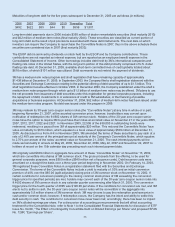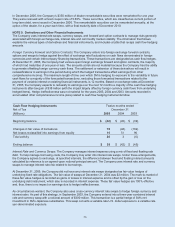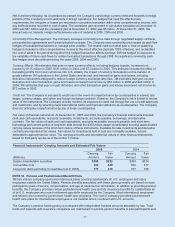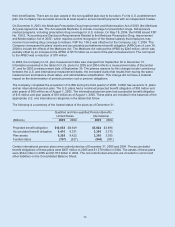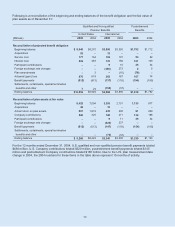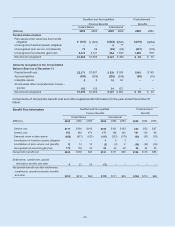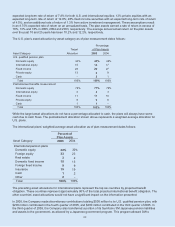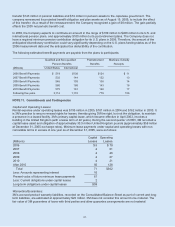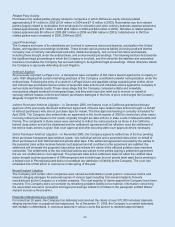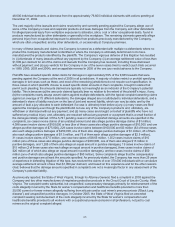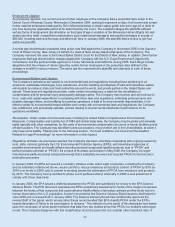3M 2005 Annual Report Download - page 91
Download and view the complete annual report
Please find page 91 of the 2005 3M annual report below. You can navigate through the pages in the report by either clicking on the pages listed below, or by using the keyword search tool below to find specific information within the annual report.
65
48,600 individual claimants, a decrease from the approximately 76,600 individual claimants with actions pending at
December 31, 2004.
The vast majority of the lawsuits and claims resolved by and currently pending against the Company allege use of
some of the Company’s mask and respirator products and seek damages from the Company and other defendants
for alleged personal injury from workplace exposures to asbestos, silica, coal or other occupational dusts, found in
products manufactured by other defendants or generally in the workplace. The remaining claimants generally allege
personal injury from occupational exposure to asbestos from products previously manufactured by the Company,
which are often unspecified, and by other defendants, or occasionally at Company premises.
In many of these lawsuits and claims, the Company is named as a defendant with multiple co-defendants where no
product the Company manufactured is identified or where the Company is ultimately determined not to have
manufactured the products identified by the plaintiffs. The Company’s vigorous defense of this litigation has resulted
in: (i) dismissals of many lawsuits without any payment by the Company; (ii) an average settlement value of less than
$1,000 per claimant for all of the claims and lawsuits that the Company has resolved, including those dismissed
without payment; and (iii) jury verdicts for the Company in six of the seven cases tried to verdict (such trials occurred
in 1999, 2000, 2003 and 2004), and an appellate reversal in 2005 of the one jury verdict adverse to the Company.
Plaintiffs have asserted specific dollar claims for damages in approximately 59% of the 9,685 lawsuits that were
pending against the Company at the end of 2005 in all jurisdictions. A majority of states restrict or prohibit specifying
damages in tort cases such as these, and most of the remaining jurisdictions do not require such specification. In
those cases in which plaintiffs choose to assert specific dollar amounts in their complaints, brought in states that
permit such pleading, the amounts claimed are typically not meaningful as an indicator of the Company’s potential
liability. This is because (a) the amounts claimed typically bear no relation to the extent of the plaintiff’s injury, if any;
(b) the complaints nearly always assert claims against multiple defendants, with the typical complaint asserting claims
against an average of 75 different defendants, the damages alleged are not attributed to individual defendants, and a
defendant’s share of liability may turn on the law of joint and several liability, which can vary by state, and by the
amount of fault a jury allocates to each defendant if a case is ultimately tried before a jury; (c) many cases are filed
against the Company even though the plaintiffs did not use any of the Company’s products and, ultimately, are
withdrawn or dismissed without any payment; and (d) many cases are brought on behalf of plaintiffs who have not
suffered any medical injury, and, ultimately, are resolved without any payment or a payment that is a small fraction of
the damages initially claimed. Of the 5,741 pending cases in which purported damage amounts are specified in the
complaints, six cases involve claims of an unstated amount and also allege punitive damage claims of $1 million;
4,098 cases involve claims of $100,000 or less (five of these cases also allege punitive damages of $10,000, and one
alleges punitive damages of $75,000), 229 cases involve claims between $100,000 and $3 million (83 of these cases
also each allege punitive damages of $250,000, one of them also alleges punitive damages of $1 million, 45 of them
also each allege punitive damages of $1.5 million, and 76 of them each allege punitive damages of $2.5 million),
31 cases involve claims of $7.5 million, one case has claims of $8.65 million, 1,352 cases involve claims of $10
million (one of these cases also alleges punitive damages of $350,000, one of them also alleges $15 million in
punitive damages, and 1,285 of them also allege an equal amount in punitive damages), 19 cases involve claims of
$15 million (2 of these cases also each allege an equal amount in punitive damages), three cases involve claims of
$20 million (all of which also allege an equal amount in punitive damages), and two cases involve claims of $50
million (one of which also alleges punitive damages of $50 million). Some complaints allege that the compensatory
and punitive damages are at least the amounts specified. As previously stated, the Company has more than 25 years
of experience in defending litigation of this type, has resolved the claims of over 370,000 individuals with a cumulative
average settlement amount of less than $1,000 per claimant, and based on this experience and for the other reasons
cited, believes that the damage amounts specified in complaints are not a meaningful factor in any assessment of the
Company’s potential liability.
As previously reported, the State of West Virginia, through its Attorney General, filed a complaint in 2003 against the
Company and two other manufacturers of respiratory protection products in the Circuit Court of Lincoln County, West
Virginia. The complaint seeks substantial, but unspecified, compensatory damages primarily for reimbursement of the
costs allegedly incurred by the State for worker’s compensation and healthcare benefits provided to more than
20,000 current or former miners allegedly suffering from silicosis and/or coal miner’s pneumoconiosis (“Black Lung
disease”) and unspecified punitive damages. In October 2005, the State of West Virginia filed an amended
complaint seeking reimbursement of the costs allegedly incurred by the State for worker’s compensation and
healthcare benefits provided to all workers with occupational pneumoconiosis in all professions, not just to coal
miners as the original complaint alleged.


